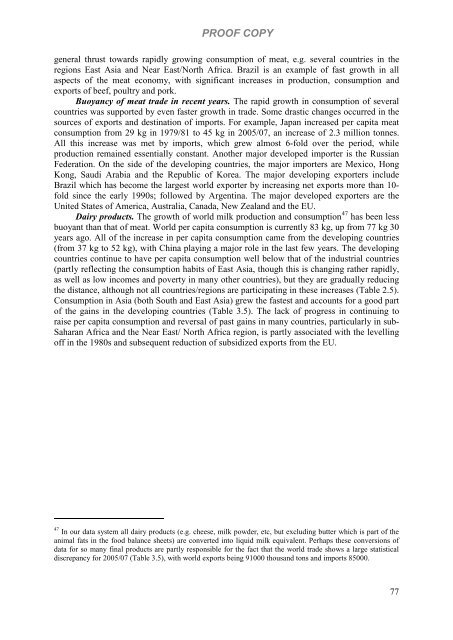World agriculture towards 2030/2050: the 2012 revision - Fao
World agriculture towards 2030/2050: the 2012 revision - Fao
World agriculture towards 2030/2050: the 2012 revision - Fao
You also want an ePaper? Increase the reach of your titles
YUMPU automatically turns print PDFs into web optimized ePapers that Google loves.
PROOF COPY<br />
general thrust <strong>towards</strong> rapidly growing consumption of meat, e.g. several countries in <strong>the</strong><br />
regions East Asia and Near East/North Africa. Brazil is an example of fast growth in all<br />
aspects of <strong>the</strong> meat economy, with significant increases in production, consumption and<br />
exports of beef, poultry and pork.<br />
Buoyancy of meat trade in recent years. The rapid growth in consumption of several<br />
countries was supported by even faster growth in trade. Some drastic changes occurred in <strong>the</strong><br />
sources of exports and destination of imports. For example, Japan increased per capita meat<br />
consumption from 29 kg in 1979/81 to 45 kg in 2005/07, an increase of 2.3 million tonnes.<br />
All this increase was met by imports, which grew almost 6-fold over <strong>the</strong> period, while<br />
production remained essentially constant. Ano<strong>the</strong>r major developed importer is <strong>the</strong> Russian<br />
Federation. On <strong>the</strong> side of <strong>the</strong> developing countries, <strong>the</strong> major importers are Mexico, Hong<br />
Kong, Saudi Arabia and <strong>the</strong> Republic of Korea. The major developing exporters include<br />
Brazil which has become <strong>the</strong> largest world exporter by increasing net exports more than 10fold<br />
since <strong>the</strong> early 1990s; followed by Argentina. The major developed exporters are <strong>the</strong><br />
United States of America, Australia, Canada, New Zealand and <strong>the</strong> EU.<br />
Dairy products. The growth of world milk production and consumption 47 has been less<br />
buoyant than that of meat. <strong>World</strong> per capita consumption is currently 83 kg, up from 77 kg 30<br />
years ago. All of <strong>the</strong> increase in per capita consumption came from <strong>the</strong> developing countries<br />
(from 37 kg to 52 kg), with China playing a major role in <strong>the</strong> last few years. The developing<br />
countries continue to have per capita consumption well below that of <strong>the</strong> industrial countries<br />
(partly reflecting <strong>the</strong> consumption habits of East Asia, though this is changing ra<strong>the</strong>r rapidly,<br />
as well as low incomes and poverty in many o<strong>the</strong>r countries), but <strong>the</strong>y are gradually reducing<br />
<strong>the</strong> distance, although not all countries/regions are participating in <strong>the</strong>se increases (Table 2.5).<br />
Consumption in Asia (both South and East Asia) grew <strong>the</strong> fastest and accounts for a good part<br />
of <strong>the</strong> gains in <strong>the</strong> developing countries (Table 3.5). The lack of progress in continuing to<br />
raise per capita consumption and reversal of past gains in many countries, particularly in sub-<br />
Saharan Africa and <strong>the</strong> Near East/ North Africa region, is partly associated with <strong>the</strong> levelling<br />
off in <strong>the</strong> 1980s and subsequent reduction of subsidized exports from <strong>the</strong> EU.<br />
47 In our data system all dairy products (e.g. cheese, milk powder, etc, but excluding butter which is part of <strong>the</strong><br />
animal fats in <strong>the</strong> food balance sheets) are converted into liquid milk equivalent. Perhaps <strong>the</strong>se conversions of<br />
data for so many final products are partly responsible for <strong>the</strong> fact that <strong>the</strong> world trade shows a large statistical<br />
discrepancy for 2005/07 (Table 3.5), with world exports being 91000 thousand tons and imports 85000.<br />
77









